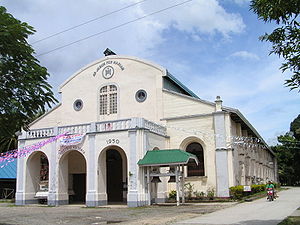
Guindulman, Bohol
Encyclopedia

Philippines
The Philippines , officially known as the Republic of the Philippines , is a country in Southeast Asia in the western Pacific Ocean. To its north across the Luzon Strait lies Taiwan. West across the South China Sea sits Vietnam...
. According to the 2007 census, it has a population of 32,355 people.
Etymology
In the olden days, names of certain places were sometimes ascribed to some usual or common incidents or occurrences as the case of the town of Guindulman. The place was originally called Guinduluman” hatched from a vernacular expression which means something or somebody who is undertaken by darkness”.There is no official record to show how the town really got its name. However, the legend reveals that during the early part of the Spanish era in the Philippines, there were only two formally organized towns along the southeastern and eastern coastal borders of Bohol, namely, Jagna and Batuanan which is now renamed Alicia. Being the only towns in those good old days, traders and even ordinary residents from each of these two places used to travel on foot either to Jagna or to Batuanan to transact business. Owing to the distance, travelers starting from either of these towns in the early morning were surely be benighted or overtaken by darkness right in this specific place; hence the name “guinduluman”.
However, because of the carefree attitude of the early inhabitants and the absence of official records, the name “Guinduluman” was later changed to the present name Guindulman. It is only regrettable to note that in the locality could ascertain the approximate date of its change. After all, the actual meaning of the given name does not alter. It is even further said that the early condition of the area, itself, had something to contribute to the appropriateness of the term because the center of the town was once surrounded and almost entirely shaded by a dense forest which also made the town dark even during daytime. Travelers from other places passing through this thick forest could observe its surrounding darkness because the sunlight could hardly penetrate through the thick foliage, thus causing darkness in the area at any time of the day. Such actual condition of the particular place, therefore, gave added significance to the created name. The term “Guindulman” is actually derived from the root word “dulom” or “du’om” in short which means “dark”.
Early Development
It is hard to fix a definite date when this town was established as official records were destroyed during the war. No living person can be found who remembers the date. However, the late Francisca L. Piezas cited in her compilation that the town of Guindulman was already been established before the Tamblot Rebellion of 1622. So Guindulman may now be more than 300 years old.Historical Events
During the Philippine revolution against the Spanish government there were no fight in town as reported. The people were submissive to the Spanish authorities.Guindulman was burned during the Philippine-American war in 1898. Guerrilla warfare was already resorted to by the local insurgents known as “insurectos”. A resistance movement organized under the leadership of Colonel Pedro Samson whose headquarters was stationed in Monte Verde in the upper part of the town of Duero. There was no battle fought in the poblacion of Guindulman, but a memorable encounter took place in the barrio of Cabantian wherein both sides suffer heavy casualties.
The historical incident happened when American troops passed by the barrio of Cabantian, the “insurectos” who had already the knowledge of their trip ambushed the troops by jumping from the hilltops and killing many American soldiers with their bolos. However, because of the superiority of the American weapons, the insurgents likewise suffered several casualties. On account of such incident, the furious American patrols then burned the houses of the particular village including the rice stocks in the fields. Still dissatisfied, they shot cows and carabaos at sight.
During the Japanese occupation way back on 1944 another encounter occurred between the Japanese troops and members of the guerrilla unit which was organized by the late Major Esteban Bernido, native of Guindulman who once became a representative of the 3rd Congressional district of Bohol, governor of the province and who finally occupied one of the important cabinet positions of the country.
The memorable incident started with an ambush made by the guerrillas under Major Esteban Bernido right at the boundary of Guindulman and Duero. The Japanese suffered heavy casualties while the guerrilla unit escaped unharmed. As a means of reprisal, the Japanese burned the entire poblacion, leaving only the convent and the church which were occupied by their garrison.
Barangays
Guindulman is politically subdivided into 19 barangayBarangay
A barangay is the smallest administrative division in the Philippines and is the native Filipino term for a village, district or ward...
s.
|
|

